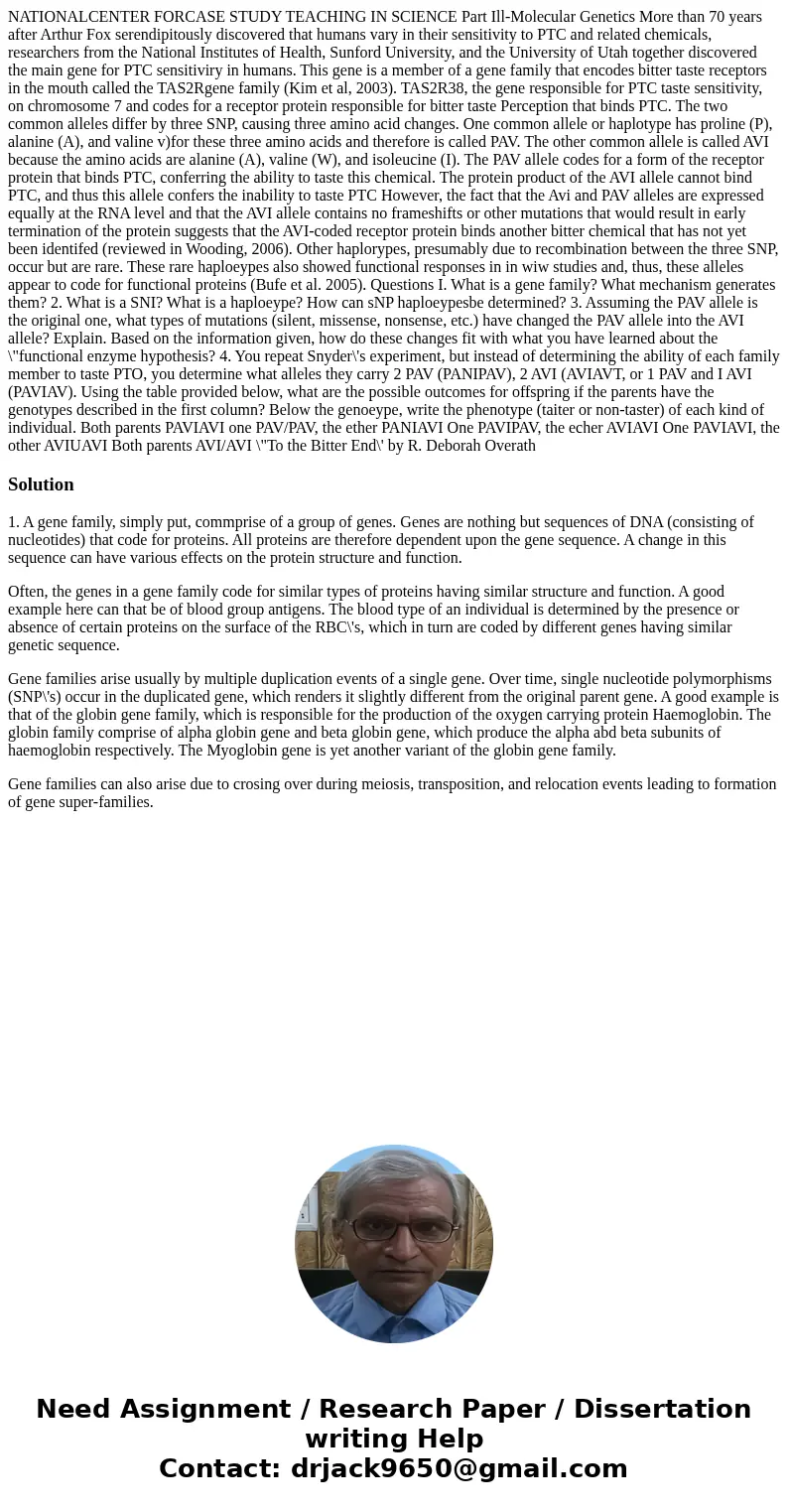NATIONALCENTER FORCASE STUDY TEACHING IN SCIENCE Part Ill-Molecular Genetics More than 70 years after Arthur Fox serendipitously discovered that humans vary in their sensitivity to PTC and related chemicals, researchers from the National Institutes of Health, Sunford University, and the University of Utah together discovered the main gene for PTC sensitiviry in humans. This gene is a member of a gene family that encodes bitter taste receptors in the mouth called the TAS2Rgene family (Kim et al, 2003). TAS2R38, the gene responsible for PTC taste sensitivity, on chromosome 7 and codes for a receptor protein responsible for bitter taste Perception that binds PTC. The two common alleles differ by three SNP, causing three amino acid changes. One common allele or haplotype has proline (P), alanine (A), and valine v)for these three amino acids and therefore is called PAV. The other common allele is called AVI because the amino acids are alanine (A), valine (W), and isoleucine (I). The PAV allele codes for a form of the receptor protein that binds PTC, conferring the ability to taste this chemical. The protein product of the AVI allele cannot bind PTC, and thus this allele confers the inability to taste PTC However, the fact that the Avi and PAV alleles are expressed equally at the RNA level and that the AVI allele contains no frameshifts or other mutations that would result in early termination of the protein suggests that the AVI-coded receptor protein binds another bitter chemical that has not yet been identifed (reviewed in Wooding, 2006). Other haplorypes, presumably due to recombination between the three SNP, occur but are rare. These rare haploeypes also showed functional responses in in wiw studies and, thus, these alleles appear to code for functional proteins (Bufe et al. 2005). Questions I. What is a gene family? What mechanism generates them? 2. What is a SNI? What is a haploeype? How can sNP haploeypesbe determined? 3. Assuming the PAV allele is the original one, what types of mutations (silent, missense, nonsense, etc.) have changed the PAV allele into the AVI allele? Explain. Based on the information given, how do these changes fit with what you have learned about the \"functional enzyme hypothesis? 4. You repeat Snyder\'s experiment, but instead of determining the ability of each family member to taste PTO, you determine what alleles they carry 2 PAV (PANIPAV), 2 AVI (AVIAVT, or 1 PAV and I AVI (PAVIAV). Using the table provided below, what are the possible outcomes for offspring if the parents have the genotypes described in the first column? Below the genoeype, write the phenotype (taiter or non-taster) of each kind of individual. Both parents PAVIAVI one PAV/PAV, the ether PANIAVI One PAVIPAV, the echer AVIAVI One PAVIAVI, the other AVIUAVI Both parents AVI/AVI \"To the Bitter End\' by R. Deborah Overath
1. A gene family, simply put, commprise of a group of genes. Genes are nothing but sequences of DNA (consisting of nucleotides) that code for proteins. All proteins are therefore dependent upon the gene sequence. A change in this sequence can have various effects on the protein structure and function.
Often, the genes in a gene family code for similar types of proteins having similar structure and function. A good example here can that be of blood group antigens. The blood type of an individual is determined by the presence or absence of certain proteins on the surface of the RBC\'s, which in turn are coded by different genes having similar genetic sequence.
Gene families arise usually by multiple duplication events of a single gene. Over time, single nucleotide polymorphisms (SNP\'s) occur in the duplicated gene, which renders it slightly different from the original parent gene. A good example is that of the globin gene family, which is responsible for the production of the oxygen carrying protein Haemoglobin. The globin family comprise of alpha globin gene and beta globin gene, which produce the alpha abd beta subunits of haemoglobin respectively. The Myoglobin gene is yet another variant of the globin gene family.
Gene families can also arise due to crosing over during meiosis, transposition, and relocation events leading to formation of gene super-families.

 Homework Sourse
Homework Sourse